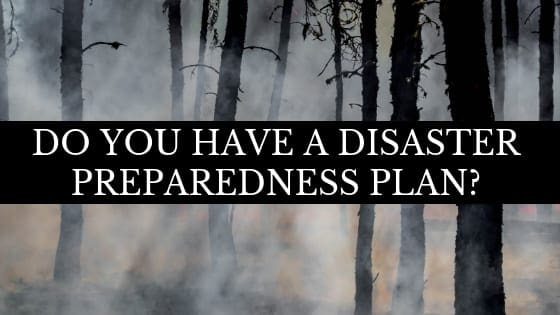
Being aware of what to do, what to pack, and where to go, may save your life and the life of your precious pets. Many people store some disaster supplies or have a general plan for the family but neglect to think ahead concerning what will happen to the family pet.
Having an established plan already in place will help you when seconds count. If you have a plan, you’ll be more in control and calm.
After a hurricane or tornado, pet rescue organizations and shelters frantically try to reunite abandoned pets with their human families. A situation that could be made far less traumatic if all pets were microchipped, and if pet parents had a disaster preparedness plan in place.
Here are some guidelines to get you started:
Prepare Before Disaster Strikes
Start by making sure all pets have identification. The most reliable form of identification is to have your pet microchipped and have a visible ID tag on a collar. The microchip procedure is very quick and can be done in your veterinarian’s office. A small chip is implanted under the skin. The process only takes seconds. You then have to register the information with a registry agency. It’s crucial that you keep the information up-to-date in case you move or change phone numbers.
As for collars with ID, not all pets are comfortable wearing them. In an emergency though where someone who finds your pet can’t get to a clinic or shelter to have the microchip read, having an immediate means of contacting you could get your precious pet back home much sooner.
Vaccinations
Make sure your pet is up-to-date on vaccinations. If your pet does escape or gets lost during a disaster, she may end up outside for quite a while and come in contact with other animals, which increases the risk of exposure to diseases.
Keep Pictures
You probably already have countless pictures of your pets on your phone but make sure you have printed photos, in addition to ones stored on the phone, that clearly show each pet individually close up as well as full body pictures. This way you’ll be able to share the photos with the most identifiable information if a pet gets lost.
Have a Pet Emergency Evacuation Kit Ready
In addition to the emergency kit that you should have for yourself and your family, here are some items that should be packed in your feline emergency kit:
extra cash
supply of pet food and water
manual can opener (for wet food)
spoon
food and water bowls
first aid kit
supply of any medication your pet currently takes
disposable litter box or a small plastic litter box for cats
litter and litter scoop for cats
plastic bags to dispose of soiled litter clumps and other trash
brush and comb for removal of debris from coat
hand sanitizer
small bottle of dish soap
toys
paper towels
a carrier that is assembled and ready to go (you may also have a soft-sided foldable one stored in the kit for convenience)
flashlight with extra batteries
copy of your pet’s medical records
towels (to grab and safely hold a panicky pet or for your pet to use for hiding)
any other items that will provide comfort to your pet
extra leash and collar or harness
Have Your Car Ready
When you know bad weather is coming, don’t let the gas get too low in the tank. Keep it filled up, top off the car’s fluids and make sure the vehicle is in shape for a quick evacuation. Keep a flashlight in your car and make sure the batteries are always fresh.
Research Safe Locations
Depending upon what type of disaster may occur, the evacuation distance/time needed, or how wide-spread, you may end up being able to stay at a pet-friendly hotel. Know where these hotels are in advance. Have a list of boarding facilities as well in case you need to keep your pets there temporarily if it’s not safe to return home. Talk with friends and family outside of the disaster area to see if they can house your family or even just your pets during this time.
Establish a Family Plan
The above guidelines are just the basics of what you should prepare. Make sure you have talked with your family and everyone understands where they should go and what they should do in the event of a disaster. Go online and print out a list of supplies you need for your family and make sure everyone knows the location of the disaster kit. Arrange for a planned meeting place in case your family members are in separate locations when a disaster strikes.
Resources for More Information
Here’s a link to the AVMA website section on pets and disasters
Here’s a link to the ASPCA page that contains tips on disaster preparedness
Here’s a link to information from the Department of Homeland Security
Here’s a link to section on pet preparedness from the Red Cross
I also urge you to take your pet to your veterinarian for microchipping. Here’s some valuable information from the AVMA on microchipping
Plan ahead. It may just save your pet’s life.
If you have a question about your cat’s behavior, you can find information in Pam’s books. Her books are available in bookstores and online. We’ve included links to Amazon here on our website.
If you have a question regarding your cat’s health, please contact your veterinarian. This article is not intended as a replacement for your cat’s veterinary care.
 Problem Solving & Advice by Pam Johnson-Bennett Cat Behavior Expert & Best-selling Author
Problem Solving & Advice by Pam Johnson-Bennett Cat Behavior Expert & Best-selling Author




